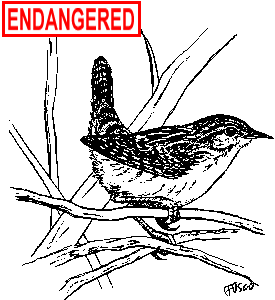Sedge Wren
Cistothorus platensis

Habitat: Drier transitional edges of freshwater marshes, bogs and wet meadows.
Weight: 0.33 ounces.
Length: 4-4.5 inches.
Wingspan: 5-6 inches.
Life Expectancy: Approximately 5 years of age.
Food: Moths, beetles, ants, caterpillars, grasshoppers, other similar insects and spiders.
Status: State endangered.
Identification: This small bird has a brown back and buffy underparts. The crown is brown streaked with white. The sedge wren also has an indistinct white eyebrow, a short, cocked tail, and a short, slender bill. The sexes are similar in appearance.
A chattering trill is sung by the male from a perch atop sedges or small bushes. The song has been likened to the rattling of a bag of marbles or the tapping of two sticks together, "chap-chap-chap-chap, chap, chap p-p-p-r-r-r."
Range: The sedge wren ranges from southeastern Saskatchewan to southern Maine, south to Arkansas, West Virginia and Virginia. It also occurs in eastern New Brunswick and Nova Scotia. The species winters from southern Texas and eastern Mexico through the lower Mississippi Valley and Gulf Coast to southern Florida and north, along the Atlantic coast, to Maryland.
Reproduction: The sedge wren breeds in late May through early June. The nest is built in sedges or rush-like grasses within 1 to 2 feet of muddy ground or shallow water. It is a well-hidden ball of woven grasses with an opening on one side. The interior is lined with cattail down, fur or feathers. Usually 6 or 7 smooth, white, short, oval eggs are laid per clutch. Sedge wrens often lay 2 clutches per year. Incubation is done by the female and lasts for 12 to 14 days. The young are tended by both adults but primarily by the female. They leave the nest 12 to 14 days after hatching.
Reason for Decline: The loss of wetland habitats through human development and degradation is the primary reason for the decline of sedge wren populations.
History in Connecticut: Sedge wrens are shy, elusive birds that are difficult to locate. Breeding birds are most apt to be observed in Connecticut during mid-May, while migrants are more common in October. During the 1800s, the sedge wren was considered an uncommon summer resident, breeding in suitable habitats near coastal Connecticut and along the Connecticut River Valley. A decline in local populations occurred by the early 1900s. The bird has been considered a very rare migrant and sporadic nester in the state since the 1960s. Nationwide Breeding Bird Survey results from 1965 to 1979 reflected a continental decline in sedge wren populations.
Interesting Facts: The sedge wren has a variety of aliases that give further testimony to its preferred habitat: meadow wren, freshwater marsh wren and grass wren. Until recently, it was known as the short-billed marsh wren and may often be referred to as such.
Male sedge wrens often build additional "dummy" nests. These nests are unlined and not as well constructed as the actual nest. Dummy nests can accumulate in great numbers where several pairs of sedge wrens are nesting as a colony.
Protective Legislation: Federal - Migratory Bird Treaty Act of 1918. State - Connecticut General Statutes Sec. 26-311.
What You Can Do: The best way to maintain populations of the sedge wren is through the conservation and protection of sedge-marsh habitat. Programs involving wetland restoration may also help provide additional breeding and nesting locations for this species.

The production of this Endangered and Threatened Species Fact Sheet
Series is made possible by donations to the Endangered Species/Wildlife Income Tax
Checkoff Fund.
(rev. 12/99)

